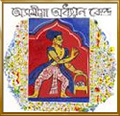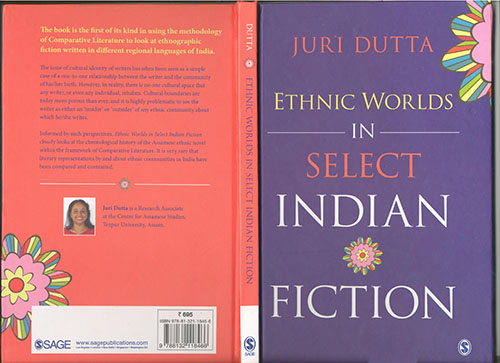



Representation of Ethnic Worlds in Select Fictions of India: A Comparative Study by Dr. Juri Dutta

The project was completed by Dr Juri Dutta and the manuscript was published by SAGE Publications Pvt. Ltd. in 2014
In North East India, a good number of novels have been written based on the life and society of the tribes. Assamese novels, representing different tribes of the North East have fetched various regional and national awards. The customs, traditions, rites and rituals of the tribes find expression in different novels of India written by writers, some of whom belong to these communities. In her work Dutta has discussed select novels of India that represent ethnic life of different communities of the country. For the purpose of this study, she has taken a few Assamese novels, along with a few non-Assamese novels based on the lives and societies of tribes and has attempted a comparative study by contextualizing each of these pieces of fiction against the socio-cultural and historical background of the times. While analyzing the novels her primary focus is on issues of ethnicity, gender and nationalism in the fiction depicting the ethnic worlds of various communities. To start with, she has discussed the tradition of ethnic novels in Assamese. In doing this, she adopts the sequential approach to make sense of the historically defined particularities of Assamese Literature. The present study is mainly based on the parallel approach to Comparative Literature to unearth both "cross-cultural constants and cultural variance" to develop an insight into "both our shared humanity and our cultural diversity" (Hogan and Pandit, 1995: xii).
This work is informed by recent understanding of the idea of representation whereby it is seen as a political project and not, as wasbelieved, to be a simplistic process of transference of knowledge and information. Who represents whom and to what purpose are political questions that are related to the intimate relationship between knowledge and power. Representation and appropriation of voice is a difficulty for all writers. Sneja Gunew points out that we use the term representation in at least two senses: as the depiction of a subject and as delegation (when someone speaks for a group or individual) (1994: 31). Writers and critics who are delegates for marginal or minority groups may find themselves in the situation of Gavino Ledda - from their position of power in the hegemony of Western civilization, how can they really speak for a powerless group? ((Paci, 1985: 47). In using the language of the dominant culture and the discourse of sophisticated theory, can they still address the concerns of the marginal community? With every university degree there is an ever-widening gap between the writer and his/her community. And so we can see that the only concrete links this person may have with these original roots is to try to speak with and for these people. The task is not unproblematic (Paci, 1985: 47). Moreover, it is worthwhile to talk about the viability of the idea of the Indian novel. Connected to this is the issue of establishment of an ethnic literary tradition in the Indian context.
In a very general sense, Indian fiction includes the fiction written by Indians of any caste or community, or, in a slightly more limited sense, novels written in any official Indian languages. Even novels depicting Indian lives and society, but written in English can be classified as Indian novels. However, she has excluded the category of the Indian English novel in her study. There are reasons for this. Firstly, there are not many works of fiction in Indian English Literature that depict lives of tribes. To some extent, the North East of India, with writers like Mamang Dai and Temsula Ao, is an exception. Secondly, the 'Indianness' that she seeks to explore lives more vibrantly in the regional literatures of India. Unfortunately, for a large number of readers, access to these novels in various regional languages of India is provided by their English translations.
The concept of "Indian" literature as a homogenized entity might be a noble idea for the advocates of the 'unity in diversity' slogan. With regards to such a notion, Dutta would like to propose the need to talk in terms of an ethnic literary tradition in India. In this context, one is reminded of A.K. Ramanujan's remark:
One way of defining diversity for India is to say what the Irishman is said to have said about trousers. When asked whether trousers were singular or plural, he said, "Singular at the top and plural at the bottom" (quoted in Guttman, 2007: 1).
Indian literature does consist of writings that Ahmad describes as "the High textuality of the Brahmanical kind" that are traditionally considered important; but as Ahmad says, it also constitutes traditions and texts that are generally excluded from the literary canon, texts and traditions that tremendously important from a literary point of view (1994: 244). Such texts which are excluded from the literary canon but important from a political and aesthetic point of view constitute the core of Dutta's discussion in this book.
Dutta's work is an attempt to compare and contrast the literary voices in the margin that have challenged, or at least altered, existing literary traditions of many Indian languages. She has discussed the ethnic worlds in Indian fictions and to that effect, this study has taken into account fictions written about the ethnic communities of India. Her work is an attempt to look at ethnic fiction in regional literatures of India from the point of view of Comparative Literature.
In the second chapter, she has focused on select Assamese ethnic novels representing tribes of the North East. The novels depicting the rites and rituals, customs and traditions of any ethnic community of the North East, written either by a writer "belonging" to that community or "outside" it has come under the purview of her study. She has begun by tracing the history of Assamese ethnic novels from the beginning till date. She has occasionally used the term ethnographic fiction to refer to these works to stress their representation of lived reality. She has however qualified the meaning of this term by saying that not all the fictions that she has been dealing with are necessarily the result of fieldwork. She has begun with a brief introductory discussion of the novels in a chronological order. In addition, she has made a division of the ethnic Assamese novels depending on the authorship (cultural identity of the authors) of these novels. The ethnic novels which are written by "insiders" (members of that particular community) and the ethnic novels written by "outsiders" (members outside that community) are discussed separately in this chapter.
It is interesting to look at the ways in which issues of development, man-environment relationship and rights of indigenous communities are addressed in contemporary Indian literature. The forest, either as a metaphorical space for projecting one's fear and fascination or as a living reality that shapes the lives of communities living in and around it has found frequent mention in different books of Indian ethnic literature. In the third chapter, Dutta looks at the ways in which Yeshe Dorjee Thongchi, Pratibha Ray and Mahasweta Devi address issues of development and human rights of indigenous communities in their fiction. She focuses attention on Thongchi's Mouna Ounth Mukhar Hriday (Silent Lips Murmuring Hearts), Pratibha Ray's Adibhumi (The Primal Land) and Mahasweta Devi's Aranyar Adhikar (Right Over the Forest).
Every literary work bears the stamp of a culture. This is true both when the writer writes about his/her culture or when he writes about a culture that he/she has studied, lived and experienced. The author creates out of what he knows, what he experiences and what he is familiar with; to express this in terms of poststructuralist philosophy, one could say that the writer creates out of what has 'always already' existed. In the fourth chapter, she has discussed the reflection of folk beliefs and customs in the novel Kocharethi by Narayan, Rangmilir Hanhi by Rong Bong Terang, Mon Aru Mon by Lummer Dai, Sawa Kota Manuh by Yeshe Dorjee Thongchi and Dhansiri Ganwar Dekajan by Sishuram Pegu. The Malayarayar tribe of Kerala, the Karbis of Assam, the Adis of Arunachal Pradesh, the Monpas of the West Kameng Districts of Arunachal Pradesh and the Misings of Bokakhat region of Assam, their beliefs and rituals, customs and traditions are depicted in the above mentioned novels.
She is aware that in many cases the act of writing fiction may be an assertion of a particular cultural identity. And the use of folk beliefs and customs in fiction can be seen as a strategy for resisting the hegemony of the dominant culture. This dominant culture may be European colonialism or Indian colonialism. In some ethnic novels it is obvious that the author writes with the idea of introducing the readers to the diverse cultural materials of a society. And if the author belongs to that particular community, he seems to be informative instead of idealistic, not romanticizing everything ethnic as 'exotic' or 'strange' (Mishra, 2001: 33).
In the fifth chapter, she has discussed Kanyar Mulya (Lummer Dai), Alma Kabutari (Maitreyi Puspa) and select short stories of Mahasweta Devi in the light of feminism. When it comes to feminist perspective in ethnic fiction, it is imperative to deal with the representation of female characters in such fiction. However, any such attempt runs against certain stereotypes about ethnic communities in India that have a powerful hold on people's imagination. For instance, it is generally believed that womenfolk in ethnic communities are less exploited and more privileged. Apparently women in ethnic communities enjoy more freedom and they have a powerful social identity. But the actual scenario might not always be so comforting. In fact, women in ethnic communities are not really privileged. In contrast, they are doubly exploited in the sense that they belong to a group which is already 'marginalized'. Moreover, they are victims of sufferings and exploitations by virtue of being women. As such, they are more vulnerable to injustice, social oppression and violence. This emerges quite clearly in a study of the representation of female characters in ethnic novels. She begins this chapter with a discussion of Lummer Dai's novel Kanyar Mulya (The Bride Price).
In Alma Kabutari Maitreyi Pushpa tackles the old Kabutara tradition of sexual slavery of the Kajja tribe. The onus of reclaiming a dignified status for her oppressed people falls on the young shoulders of Alma. In depicting this, Pushpa redefines the contours of traditional female heroism in the context of contemporary Indian fiction. Irrespective of the evident discomfort of some Indian women writers with the 'feminist' label, it is amply clear that women in the Indian context are doubly marginalized. Ironically, many of the women characters that have been looked at in this chapter belong to communities that are in any case marginalized. One also needs to contest the often stated view that India is a land where women are worshipped as goddesses. It needs to be seen that "the respect and privileges which accompany the position of a 'devi' (Goddess) are not only anti-individualistic," but also "deny women a personhood" (Jain, 2001: 10). On the other extreme in our society, women are just treated as sexual objects or things of exchange, again denying their humanity, their wishes and desires, their self.
To conclude, though there is a lot of literature being written by and about the ethnic groups of India, not much attention has been given to understand the shared aspects of these ethnic worlds in terms of ethnic identity, issues of gender and of the impact on these societies of nation-building and development measures. Dutta asserts that Comparative literature is among other things, a search for literary universals. Empathic 'literary universals' is "an antidote" to "annihilating, nonassimilative, separatist universalism" (1995: 207).
References: